Traditional prospecting casts a wide net, but B2B buyers have never been pickier about who they'll talk to. Generic outreach is ignored, cold calls go straight to voicemail, and mass email campaigns land in spam folders.
Account-based prospecting works with better math. You outline 50 companies that are actually likely to buy from you, not 500 random prospects hoping a few will respond.
Then, you look at their recent announcements and tech stack, find out who the decision-makers are, and map out how your solution fits their specific needs.
When you finally do reach out, you're talking about problems they actually have. Yes, you’ll have fewer prospects, but the conversations you have will be much more meaningful.
Below, we'll show you how to implement account-based prospecting properly, not the "Hi [Company Name]" approach that fools nobody.
What is account-based prospecting?
"Account-based" gets slapped onto every sales strategy these days. Companies rebrand their existing outreach as "account-based" but barely change anything except the prospect's company name in email templates. Real account-based prospecting methods involve much more than surface-level personalization.
Here’s how we define it:
Account-based prospecting is a focused sales approach that targets a select group of high-value accounts through deep research and coordinated, multi-stakeholder outreach campaigns. You treat each target company as a mini-market that needs its own strategy.
Account-based prospecting works when it follows three core principles:
- Account selection: Find accounts that match your ideal customer profile and rank them based on fit, potential deal size, and recent buying signals. Quality beats quantity here, so it’s better to target 50-100 accounts instead of 1,000+ leads.
- Research and intelligence: Study each target company's business model, recent news, key projects, and decision-makers. Learn about their current tech setup, pain points, and buying process to inform your approach.
- Personalized outreach: Write messages that mention specific company pain points or opportunities, and contact multiple people within the same account in a coordinated way. Time your outreach around relevant business events or company news for maximum impact.
To be specific, here's how account-based prospecting might work for a marketing automation SaaS company:
- Traditional approach: Create a list of 1,000 marketing managers, send them all a similar email about "increasing marketing ROI," and follow up with generic templates.
- Account-based approach: Find 50 high-growth SaaS companies that just raised funding. Let's say your research shows that Pied Piper hired a new CMO and wants to expand into Europe.
Your outreach message talks about their expansion plans and shows how marketing automation can help them run campaigns across different regions. Follow-up messages go to their Head of Demand Gen and VP of Sales, each with content tailored to their specific role in the expansion.
Why account-based prospecting works in today’s B2B environment
- B2B buyers are overwhelmed with generic sales messages and have become extremely picky about who they'll talk to. They want vendors who understand their business and can speak intelligently about their issues.
- Sales cycles in B2B have also become more complex, with multiple decision-makers involved in every purchase. Each person cares about different things – the CFO worries about cost, the IT director thinks about implementation, and the end users focus on daily workflow.
- Buyers also do their own research before they talk to vendors. They read reviews, compare solutions, and often know exactly what they need before even taking a sales call.
What’s the difference between account-based prospecting (ABP) and account-based sales (ABS)
These two terms get mixed up constantly, and it's easy to see why. Both focus on target accounts, both require research, and both involve personalized outreach. But they serve different purposes in your GTM strategy.
The key difference is about where you are with the account:
Account-based prospecting is what you do when there's no active opportunity. You're trying to get on someone's radar, book that first meeting, or restart a conversation that went cold. The goal is to create interest where none existed.
Account-based sales is what happens when you have an active deal in motion. There's a budget, a timeline, and specific pain points. You're managing a live opportunity through to close.
Account-based prospecting gets you the first meeting with a key stakeholder. Once that meeting happens and the prospect shows interest, account-based selling takes over to guide the opportunity through the full buying process.

You can't do account-based sales without first doing account-based prospecting. But you can do prospecting without having a full account-based sales process, though you'll probably struggle to close the deals you start.
Other common acronyms and names
The account-based world loves its acronyms. You'll see ABM, ABX, ABE, and others thrown around constantly. Here's what they mean and how they connect to account-based prospecting:
- ABM (Account-based marketing): A marketing strategy that focuses resources on a specific set of target accounts. Marketing teams create personalized campaigns, targeted ads, custom content, and direct mail for individual companies. The goal is to warm up accounts before sales reaches out and streamlines the sales process with relevant touchpoints.
- ABX (Account-based experience): Creates consistent, personalized experiences across every customer touchpoint. It involves coordination between marketing, sales, customer success, and product teams to ensure target accounts get a seamless experience throughout their entire journey.
- ABE (Account-based everything): The most comprehensive approach where every function in your company – marketing, sales, customer success, product, support – aligns around your target accounts. ABE means turning your entire company into an account-based operation.
Account-based prospecting fits into all of these frameworks as the direct outreach component.
Whether you're running outbound ABM campaigns, creating ABX programs, or implementing full ABE strategies, you still need someone to pick up the phone and start conversations with your target accounts.
The tactical advantages of a modern account-based prospecting strategy
Focus your prospecting on fewer, better-fit accounts and you'll start seeing benefits across your entire sales process:
- Get higher response rates with research-driven messages: Instead of "Hi, I noticed you work in healthcare," you can write "I saw X covered your recent $50M Series B – congrats on the expansion into telehealth." Personalized messages receive 32.7% more replies than generic outreach.
- Build relationships across the entire buying committee: You talk to multiple people from day one rather than hoping one contact will champion your solution internally. This creates broader support and kills single-point-of-failure scenarios.
- Close deals faster with better-qualified opportunities: You enter conversations already knowing their pain points, budget signals, and buying timeline. Nurtured leads move through the sales cycle 23% faster than non-nurtured leads.
- Larger average deal sizes and contract values: You're going after enterprise accounts with real budgets instead of small deals that barely move the needle. A focused list of 50 tier 1 and 2 accounts outperforms a generic list of 500 in terms of deal quality and size.
- Better pipeline quality and conversion rates: Your CRM fills up with prospects who can afford your product, not college students doing research or companies with $500 budgets.
How to get started with account-based prospecting: A 5-step guide
Account-based prospecting doesn't have to be complicated. Follow these five steps to launch your first campaign:
Step 1: Forge an unbreakable sales and marketing alliance
Account-based prospecting fails when sales and marketing work in silos because you end up with mixed messages, wasted effort, and confused prospects. If marketing is driving leads for SMBs while sales is targeting enterprise accounts, you're wasting everyone's time.
What to do:
- Get both teams in a room and agree on your ideal customer profile together
- Create shared target account lists that both teams work from
- Set up regular meetings to discuss which accounts are responding and which aren't
- Define clear handoff processes for when marketing warms up a successful account and sales takes over
- Use the same messaging framework so prospects hear consistent value propositions
One marketing leader on Reddit broke down exactly how they structure sales and marketing alignment, and it's a perfect example of what a coordinated ABS strategy requires:
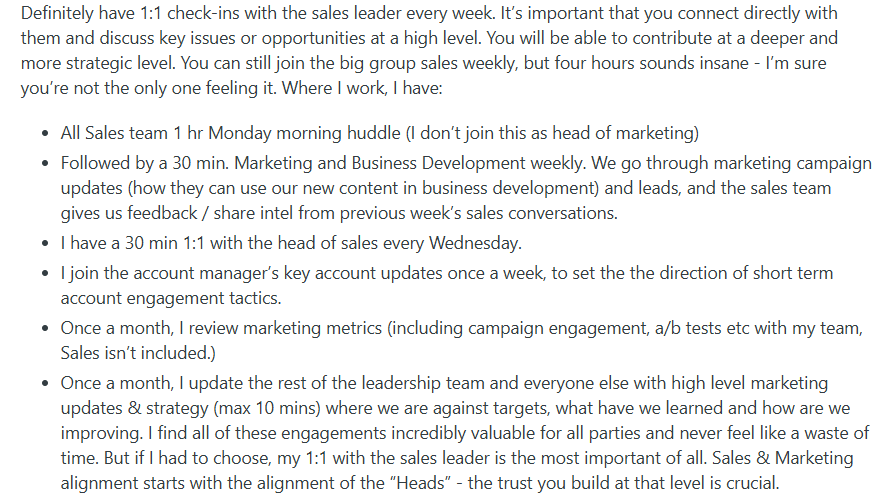
⚠️Common mistakes to avoid: Don't let sales create their own target list while marketing works from a different one. Avoid having different value propositions for the same accounts, and don't skip the regular check-ins, thinking "we'll figure it out as we go."
Related → Tips to improve how sales and marketing work together
Step 2: Evolve from a static ICP to a dynamic target account list (TAL)
Most companies create an ideal customer profile once and never touch it again, but markets change, and so do your best customers. A static ICP means you're still chasing last year's targets while missing out on new business and potential customers that could be even better fits for your current solution.
What to do:
- Review your closed-won deals from the last 12 months and outline common patterns apart from basic firmographics
- Create a scoring system that ranks accounts based on fit, intent signals, and chances to buy
- Build a living list of 50-100 target accounts and update it quarterly based on new data
- Use specialized tools to track buying triggers like hiring, funding, or technology changes, and optimize your account selection based on real-time data
- Regularly remove accounts that no longer fit and add new ones that match your criteria
⚠️Common mistakes to avoid: Don't create a massive list of 500+ accounts thinking more is better – you'll end up with shallow research and generic outreach. Also, resist the urge to target accounts just because they're big names if they don't fit your ICP criteria.
Related → Complete Guide to Account Targeting Strategy for B2B Success
Step 3: Identify the buying committee and key personas
B2B purchases involve multiple stakeholders, and if you're only talking to one person, you'll probably lose the deal.
As one sales professional on Reddit pointed out, these buying committees can include anywhere from 3 to 27 people, each with different goals, agendas, and decision-making processes:

What to do:
- Research each target account to identify the economic buyer, technical evaluator, and end users who will influence the decision
- Look for the internal champion who can sell on your behalf and the potential blockers who might resist change
- Use LinkedIn and company websites to map out reporting structures and understand who has budget authority
- Plan your outreach sequence to reach multiple contacts at each account in a coordinated way
⚠️Common mistakes to avoid: Don't assume the person with the fanciest title is the decision maker. Often, the real influencer is someone lower in the organization. Avoid reaching out to everyone at once without a strategy, and don't ignore the technical folks who can kill your deal even if the business side loves you.
Step 4: Activate your plays with personalized messaging and coordinated outreach strategy
You've outlined all the right people, but if your outreach isn't coordinated, you'll end up stepping on your own toes. When stakeholders compare notes and realize they got different messages or conflicting information, it only makes your company look disorganized.
What to do:
- Create different messaging tracks for each buyer persona in the committee based on their role and priorities
- Coordinate your outreach timing so multiple stakeholders don't get hit with emails on the same day
- Use multiple channels like email, LinkedIn, phone calls, and even direct mail to break through the noise
- Reference specific details about their business, recent announcements, or industry pain points in every touchpoint
Here's how Noah Bastien, Senior ADR at UserGems, structures his outreach to provide value before making any sales pitch:
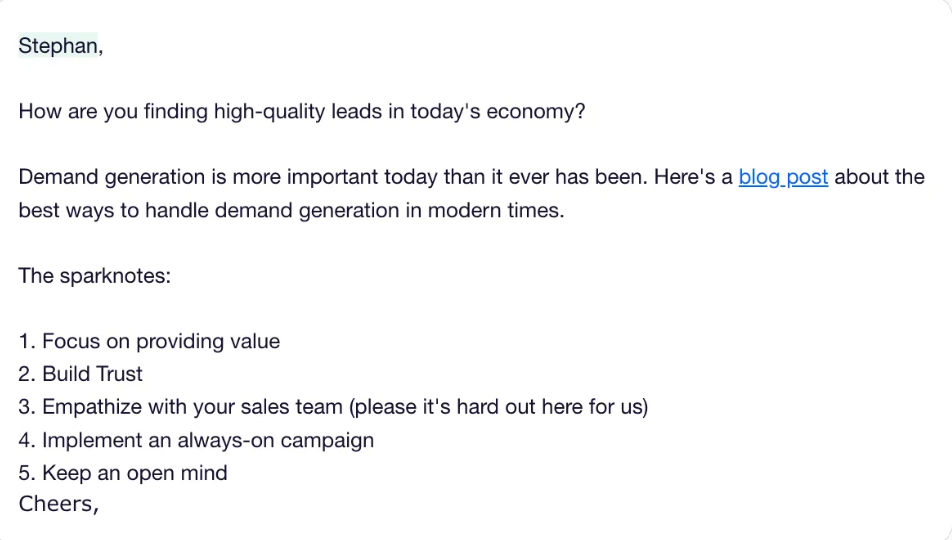
⚠️Common mistakes to avoid: Don't send the same message to the CFO and the IT director, they care about completely different things. Avoid blasting everyone at the company on the same day, and don't mistake basic mail merge personalization for real research-based customization.
Step 5: Measure pipeline, not just activity
Traditional prospecting methods focus on activity key metrics like emails sent and calls made, but account-based prospecting is about quality over quantity. You need to track whether your targeted approach generates qualified opportunities and revenue, not just whether you're staying busy with outreach activities.
What to do:
- Monitor deal velocity and average contract value from target accounts versus non-target accounts
- Set up attribution tracking so you can see which accounts and tactics are generating real opportunities
- Track account engagement across multiple touchpoints to see which accounts are showing genuine interest versus just polite responses
- Measure pipeline generated from target accounts versus random inbound leads to prove the value of your account-based approach
- Set up monthly reviews to analyze which account types, personas, and messages produce the best pipeline results
⚠️Common mistakes to avoid: Don't get trapped with vanity KPIs like open rates and response rates that don't correlate with revenue. Also, resist the urge to abandon the approach too quickly. Account-based prospecting can take a few months to show its full impact on pipeline quality.
Effective account-based prospecting techniques
Once you've got the basics down, these techniques will help you stand out from all the other reps hitting the same accounts:
Using buying signals as your reason to reach out
Cold outreach feels cold because you have no real reason to contact someone. Buying signals give you that reason. When a company raises funding, hires new executives, or expands into new markets, they're actively making changes that might need your solution.
You can't just say "Congrats on the funding round" and expect a response. A much better option is "I saw you raised $20M to expand internationally. We've helped three other SaaS companies work out compliance issues in European markets during similar growth phases."
Watch for these signals:
- New executive hires in departments your solution serves
- Funding rounds or acquisition announcements
- Job postings that signal new marketing campaigns and projects
- Technology changes or system migrations
- Expansion into new markets or locations
Your prospects respond because you reach out at exactly the right moment. They're already thinking about the problems you solve, so your message feels relevant, not random.
💡PRO TIP: UserGems tracks buying signals like job changes and funding announcements across your entire target account list automatically. When a VP of Sales joins one of your target companies, you get an alert within hours along with their contact information and AI-generated messaging that mentions their new role and how your solution can help them succeed.
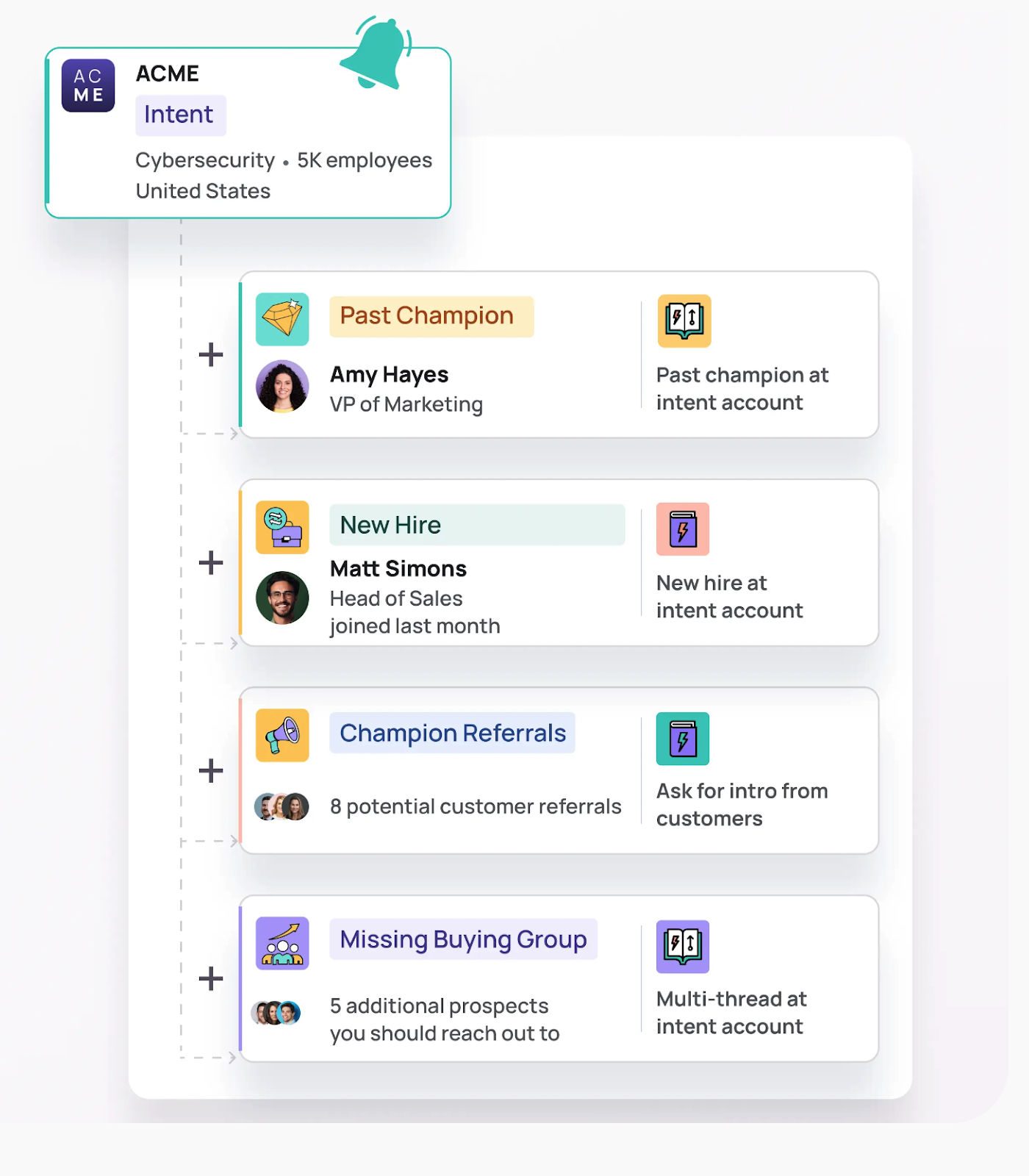
Multi-threading to build consensus
Most B2B deals die when your single contact leaves the company, gets busy, or loses internal political capital. That’s why you need to build customer relationships with multiple people across the buying committee from day one.
You need to map out who influences the decision and who holds budget authority. The person who loves your demo might not control the purse strings. The IT director who seems uninterested could kill your deal if you ignore them.
Start with these key roles:
- Economic buyer (usually C-level or VP)
- Technical evaluator (IT or operations leader)
- End user champion (person who'll use it daily)
- Procurement contact (if it's a large organization)
Space out your outreach over 2-3 weeks so you don't look desperate. When multiple people mention your solution in internal meetings, you create momentum that single-threaded approaches can't match.
💡PRO TIP: UserGems tracks when any member of a buying committee changes jobs, not just your main contact. When the IT director who evaluated your solution six months ago moves to a new company, you get an alert to reconnect - often before they've even updated their LinkedIn profile.
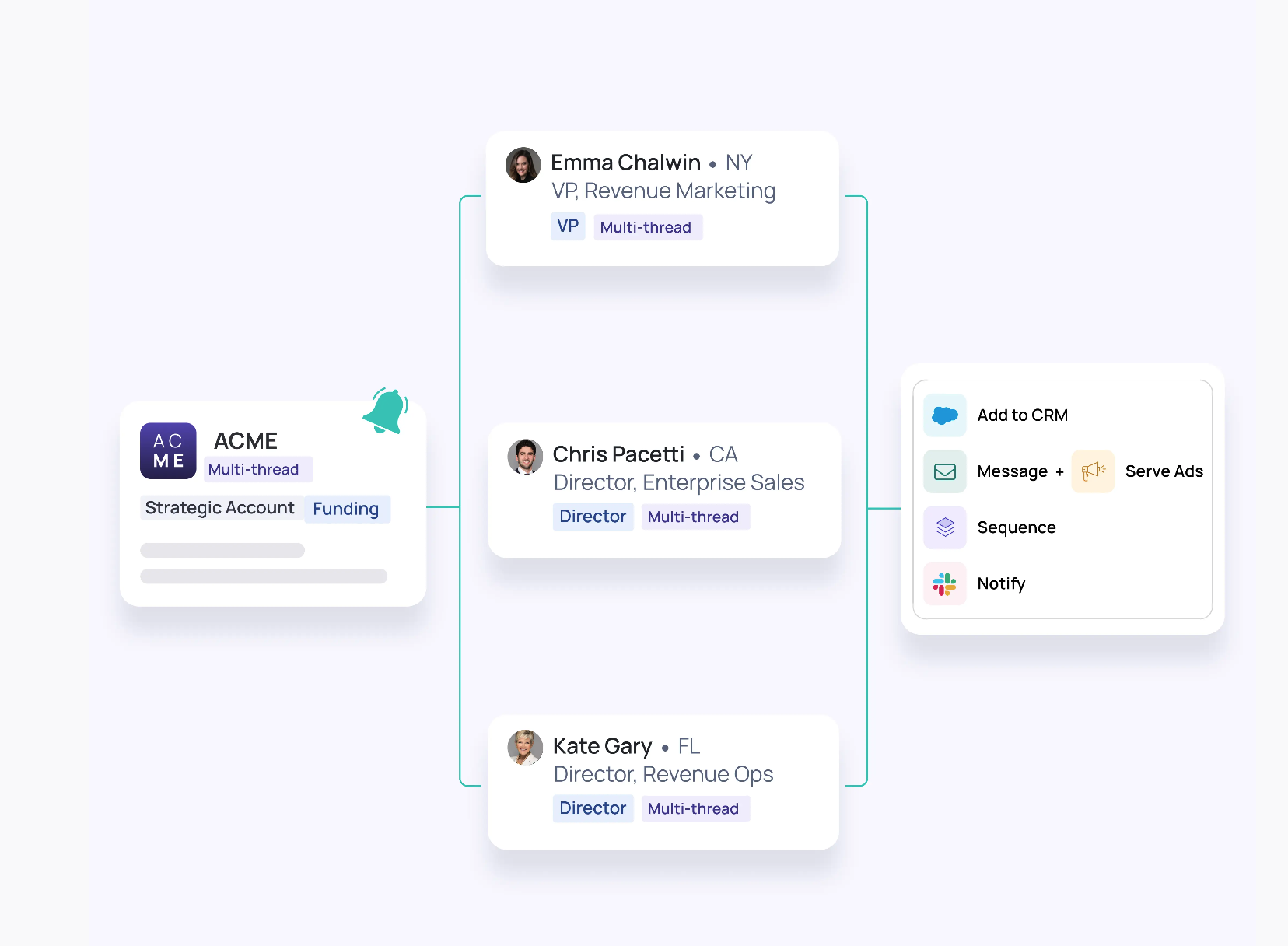
Related → How much is multithreading worth to your pipeline and revenue?
Orchestrating multi-channel plays
Email alone won't cut it when you're trying to break through to busy executives at target accounts. The best account-based prospecting combines multiple touchpoints across different channels to create a coordinated campaign that's hard to ignore.
Think of it like a symphony - each channel plays its part at the right time. Marketing sends targeted LinkedIn ads and industry content while sales follow up with personalized emails. Your prospect sees your company everywhere they look, but it feels intentional.
Here's a simple sequence that you can try out:
- Week 1: Marketing targets them with LinkedIn ads and relevant content
- Week 2: Sales sends a personalized email that references their recent activity
- Week 3: Follow up with a LinkedIn connection request and message
- Week 4: Make a phone call that ties back to previous touchpoints
The key is coordination between teams and consistent messaging across channels. When your prospect finally takes a call, they already feel like they know you.
Personalizing outreach by persona
One-size-fits-all messages don’t work anymore. Each person you contact has different priorities, speaks a different language, and cares about different outcomes.
Your research should outline what each person cares about. You can look at their social media posts, recent interviews, or company announcements they've been quoted in to figure it out.
Match your message to their world:
- C-suite: Strategic outcomes, competitive advantage, market positioning
- Finance: ROI metrics, cost savings, budget impact, risk mitigation
- Operations: Implementation ease, team adoption, workflow improvements
- IT: Security, integrations, technical requirements, support quality
The best personalization feels effortless because you're speaking their language about things they already think about.
💡PRO TIP: UserGems automatically digs into each contact's background, role, and company details, then Gem-E writes messages that speak directly to their situation.
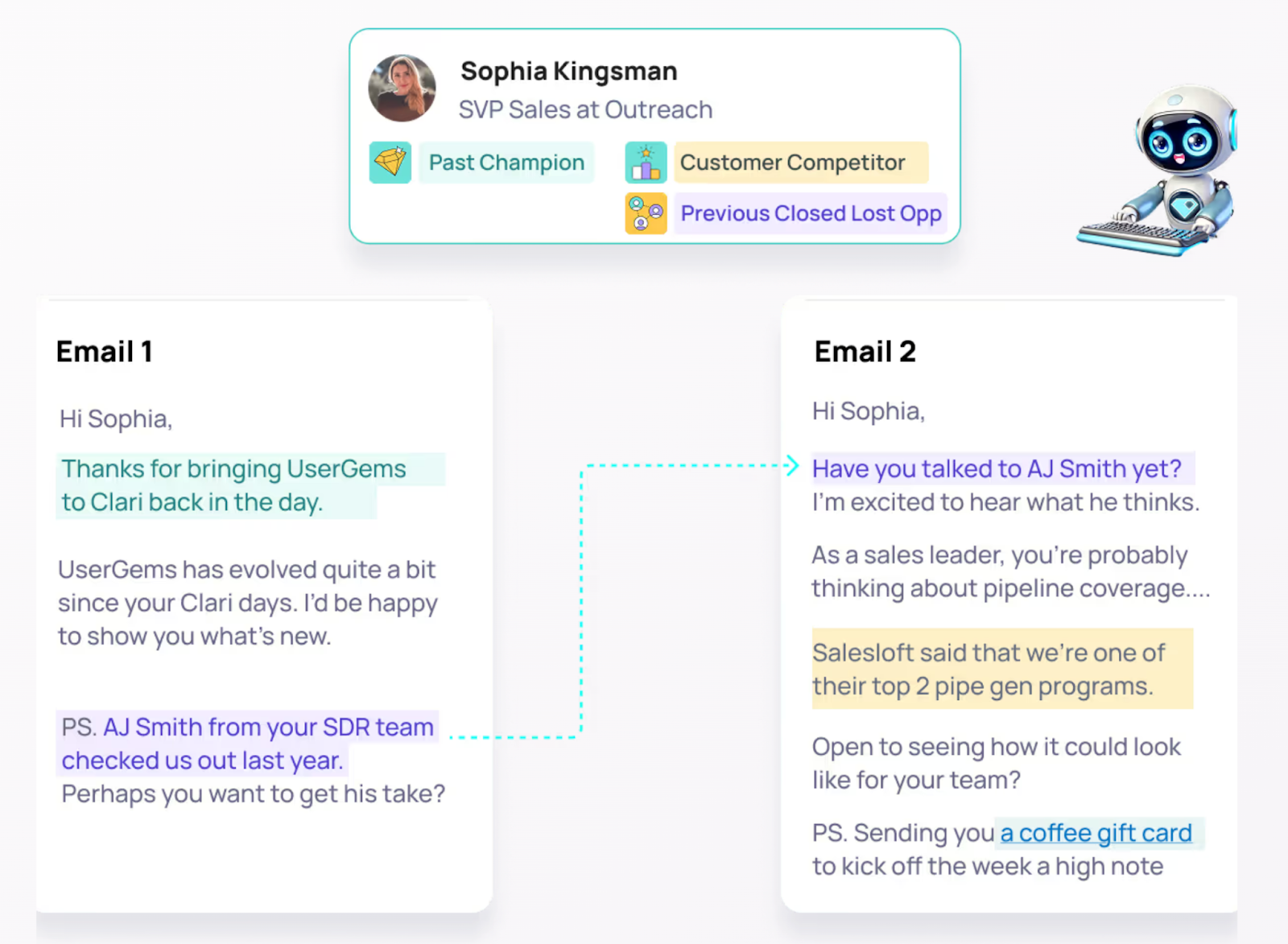
Account-based prospecting workflow examples
Account-based prospecting sounds great in theory, but most teams struggle with the actual execution.
Here are proven workflows you can start using today, from simple tactics that work for any team to advanced plays that need more coordination and tools:
Beginner plays
When you start with account-based prospecting, pick simple plays that work without fancy sales tools or hours of research. These workflows help you build good habits while you see real results quickly.
- Follow your champions to new companies: When someone who loved your product at their old job moves to a new company, reach out within their first 30 days. They already know your value and often have budget authority to bring solutions they trust to their new role.
- Target new hires and fresh promotions: Fresh faces often mean fresh budgets and new priorities. A newly promoted VP of Sales might be looking to upgrade their tech stack, while a new CMO could be evaluating their entire marketing operation.
- Hunt where companies are hiring: When a company posts jobs for roles your solution serves, they're clearly investing in that function. A startup hiring its first customer success team probably needs CS software.
- The LinkedIn warm-up sequence: Connect with prospects first, like their posts for a week, then send a message about something they shared. You build familiarity before you pitch anything.
- Follow up on trigger events with congratulations: Funding announcements, product launches, or office moves give you perfect reasons to reach out.
💡PRO TIP: UserGems has a complete library of account-based prospecting playbooks sorted by difficulty level from beginner to pro. For teams just getting started, check out the AI messaging for event nurture playbook, where you can use Gem-E to write personalized emails based on the signals it outlines (e.g., when someone attends a webinar), without spending hours on manual research.
Here’s an example of a standard pre-event email with AI personalization:
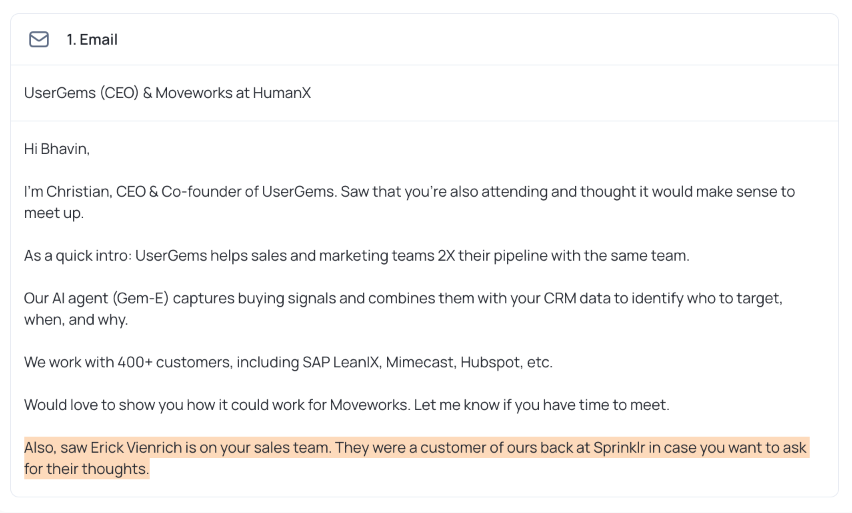
Intermediate plays
These tactics require a bit more planning and coordination but deliver much better results than basic outreach. You'll need some tools and processes in place, but the payoff is worth the extra effort.
- Multi-threaded account penetration: Map out the entire buying committee at your target accounts and coordinate outreach to multiple stakeholders over 4-6 weeks. Start with lower-level champions who are easier to reach, and then use those conversations to get introductions to decision-makers.
- Account-specific content creation: Create custom landing pages, case studies, or ROI calculators that speak directly to individual high-value accounts. When a $500K deal is on the line, spending more time on personalized content is worth the investment.
- Cross-functional account plays: Coordinate outreach between sales, marketing, and customer success to create multiple touchpoints across different channels. Marketing runs targeted ads while sales does direct outreach and customer success shares relevant case studies.
- Use an AI copilot for outbound sales: Stop burning hours on manual research when AI can do the heavy lifting for you. Set up an AI tool to scan for buying signals, find the right contacts, and even write your first drafts. You just review and send.
💡PRO TIP: For intermediate-level prospecting, check out the Gem-E AI copilot playbook, which shows you exactly how to set up AI that finds account patterns, picks the best contacts, and writes messages. Gem-E digs up insights about who reports to whom, recent company changes, and buying signals that would take you hours to find on your own.
Advanced plays
For advanced plays, you’ll need more advanced tools and tight coordination across your entire revenue team. They're worth the complexity when you're going after high-value enterprise accounts where deals can make or break your quarter.
- AI-powered hyper-personalization at scale: Use AI to analyze thousands of data points about each prospect and generate personalized customer acquisition messaging that references their specific role, company pain points, recent news, and even their personal interests.
- Revenue orchestration across the entire customer lifecycle: Coordinate outreach not just for net-new prospects, but also for upsell expansion opportunities within existing customers, win-back campaigns for churned customers, and partner channel plays.
- Executive relationship mapping and orchestration: Map executive relationships across your target accounts and systematically build connections at the C-level through board connections, industry events, and strategic introductions.
💡PRO TIP: For enterprise-level automation, check out our always-on outbound campaign playbook that shows how to combine AI, signals, and gifting at scale. The system monitors accounts for job changes, new decision-makers, and competitor signals, then automatically creates contacts in your CRM, writes personalized emails, and can even include personalized gift links.
Here’s an example of how Gem-E picks prospects:
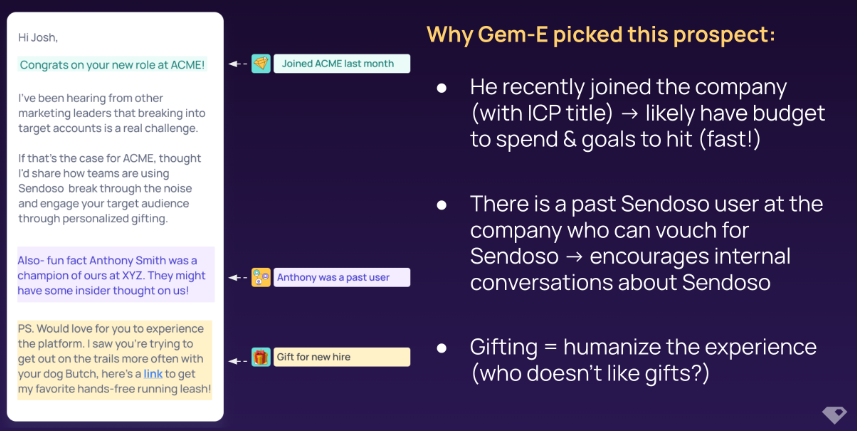
The easy button for account-based prospecting
You know that account-based prospecting works. Research accounts, find buying signals, craft personalized messages, coordinate marketing efforts across multiple stakeholders – it all makes sense on paper.
The problem is that doing all this manually will crush even your best sales teams under the weight of endless research and data entry.
That's exactly why we built UserGems.
UserGems is an AI outbound platform that automates your entire account-based prospecting workflow. You get an AI agent that handles the heavy lifting while you focus on having conversations and closing deals. No more burning hours on spreadsheets and manual research.
Here's how we make account-based prospecting easier:
- Never miss a buying signal again: Our AI continuously scans your target accounts for champion job changes, new executive hires, funding announcements, and dozens of other buying signals. No more hoping you'll catch important changes on LinkedIn.
- From signal to sales queue in seconds: The moment we spot a key signal, UserGems creates the contact in your CRM, enriches it with all the details your reps need, and drops a ready-to-go task in their queue. Zero manual data work.
- Get the perfect first draft every time: Gem-E, our AI agent, writes personalized emails that combine the specific signal with your CRM data and value proposition. Your reps get messages that sound like they came from your best researcher.
- Work inside the tools you already use: We integrate directly with Salesforce, Outreach, Salesloft, and HubSpot. Your team wakes up with prioritized accounts for lead generation and draft messages already loaded in their familiar tools.
- Scale without losing the human touch: Automate the research and first drafts, but keep your reps in control of the conversations and customer experience. They review, customize, and send, focusing on relationship-building and retention instead of data hunting.
SeekOut discovered first-hand just how powerful this strategic approach can be. They had thousands of recruiter users who had changed jobs, but no way to track and reach out to them systematically.
After implementing UserGems, they saw 5x ROI in their first year and turned job change tracking into their best outbound pipeline generation tool.
Oh, and we're so confident UserGems will transform your outbound results that we back it with a guarantee. If you don't generate pipeline that covers your UserGems investment, we'll refund your money.
Book a demo now and see how easy account-based prospecting can be with the right tools.
FAQs
How is this different from the account-based marketing (ABM) our team is already doing?
Account-based prospecting focuses specifically on direct outreach to get that first meeting, while ABM typically covers broader marketing activities like content, ads, and events.
Think of account-based prospecting as the "human touch" component that gets prospects on the phone, whereas ABM warms them up through marketing channels.
My sales reps like to control their own outreach. How do I get their buy-in for an automated platform?
Explain that automation handles the research and writing, not the relationship building. Reps still review every message before it goes out and take over once prospects respond.
Most reps love having an AI assistant that does the grunt work so they can focus on actual conversations instead of spending hours crafting emails.
How do you measure the success of automated outbound plays?
Track pipeline created and revenue influenced, not just activity metrics like emails sent or open rates. Measure response rates, qualified meetings booked, and new opportunities from your target accounts compared to traditional prospecting methods.
The real test is whether your automated plays are creating more qualified pipeline with less manual effort from your reps.
We already have intent data. Why isn't that enough?
Intent data tells you what companies are researching, but not who to contact or what to say to them.
You still need to outline the right people within those companies, write personalized messages, and execute coordinated outreach campaigns


